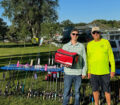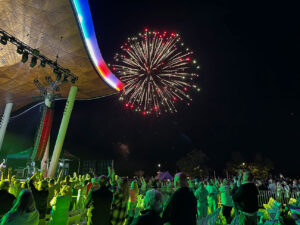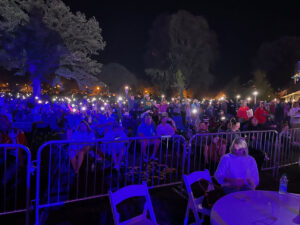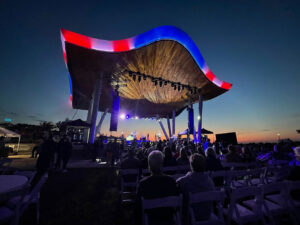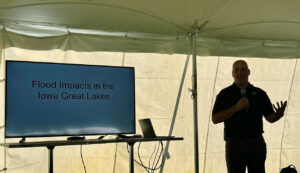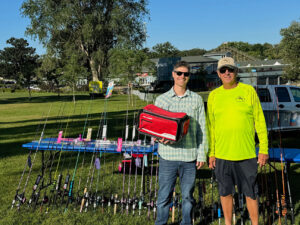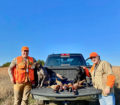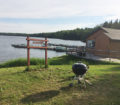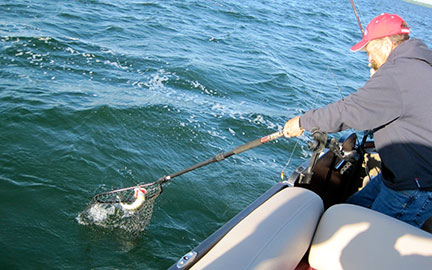By Steve Weisman
The 9th annual Okoboji Blue Water Festival (OBWF) held this past Saturday drew one of the largest crowds ever! Starting at 8 a.m., with Chalkstock, Preservation Plaza came alive with both young and old alike, residents and visitors, enjoying the many activities of the largest clean water festival in Iowa set along the shores of West Lake Okoboji.
Festival goers meandered through the winding sidewalk lined with over 30 clean water organizations, stopping to visit with different clean water organizations, gathering clean water information and in some cases joining organizations to help join with their clean water efforts.
Julie Peterson, co-chair of the OBWF, reflected on the crowd in attendance. “Families streamed by hundreds through the activities, and a lot of water quality education was provided along with a lot of fun! It’s hard to put a number on an event like this without tickets, but the crowds were huge throughout the day and at the night concert.”
Most certainly youngsters were involved in their many activities, evidenced by their excited voices, laughter and screams of joy. And why not with the chance to experience Chalkstock, the big inflatable, interactive water tables, face and T-shirt painting, lots of giveaways and even a little quiet story time provided by the Milford Library.
Barbara Mendenhall, secretary of the Okoboji Protective Association (OPA), which was one of the exhibitors, said, “A lot of people stopped by the OPA booth asking questions to learn more about the OPA and its mission. We feel it was a great day.”
Terry Thomsen, president of the Iowa Great Lakes Fishing Club (IGLFC), agreed. “We were busy the entire time and signed up 30 new members. We want to thank Dan Spengler for his great fishing clinic, helping provide all the product and helping promote our club. The casting contest for kids really went over well.”
Highlights of the day included the special presentations under the Big Tent: the Fishing Seminar with Dan Spengler, Shoreline Stabilization Update with Mike Hawkins and the Clean Water Keynote Speakers with Art Cullen and Chris Jones. Peterson noted, “All of the speakers were recorded and will be posted on the Okoboji Blue Water Festival website later next week.”
The Art and Science of Fishing
Dan Spengler’s fishing seminar was standing room only with the crowd spilling out beyond the Big Tent. Spengler’s topics included something for all anglers of all ages: Understanding the Water Body, Advanced Panfish Tactics, Jerk Baits, Finesse Fishing, Top Water Fishing, Crankbaits and Spinner Baits and Baits Designed for Forward Fishing Sonar. Spengler used a small aquarium to demonstrate what each bait/lure looked like in the water!
Although Spengler has been designing hard baits at Pure Fishing for 14 years, he was actually fascinated with making lures from age nine. Using a pocket-knife, he would whittle and shape wood lures from scraps of wood and tree branches. Spengler actually showed a tackle box containing many of his first baits!
The process was painstakingly slow early on having to use just the pocket-knife. However, the use of a Dremel tool helped make the process go more smoothly in the process of cutting, grinding and sanding. Spengler took the time to encourage the youth in the crowd to reach for their dreams, because they can be achievable!
Shoreline Stabilization
The June flood had a tremendous impact on people throughout northwest Iowa. Iowa DNR Fisheries Biologist, Mike Hawkins presented information about how the flood affected Dickinson County lakes. “A total of 78 bank collapses occurred affecting 2700 feet of shoreline on private property and another 585 feet of public shoreline.”
Hawkins gave data that showed that from March to July, the lakes rose a total of 4.3 feet and came within 6 inches of the high-water level of 1993. That much rain in just a couple of days is not normal, but the question is what is normal?
A wide range of issues caused the bank collapses. The majority of multiple collapses occurred on West Okoboji along Browns Bay, Echo Bay and Manhattan Bay. The watershed around the lakes itself caused issues of “plumbing the watershed.” This is removal of water from the land, instead of letting it soak in. By the time the water gets near the lake, there are issues with drainage from behind and off the streets, rainfall running from roofs on the lake homes. All this water put pressure on the steep banks and saturated the top, while the rising water and wave action attacked the bottom shoreline.
Hawkins went on to discuss next steps, Currently, lake homeowners are cleaning up what they can, but as far as rebuilding the shoreline, there are a lot of discussions going on with FEMA, the NRCS, the DNR and other entities that can offer expertise and also help determine if there is any funding available. Bottom line? It is everybody’s responsibility to help implement better practices throughout the watershed.
Hawkins also shared something I had no ideas was coming. “I wanted to make this announcement. We’ve talked with a few groups in the area, about the reintroduction of paddlefish to the Iowa Great Lakes. As a fisheries biologist, we don’t get to do this type of thing very often, especially a native species. To bring back a native species back into the lake is a pretty big deal. It’s a unique opportunity. We’ve been talking about this inside the fisheries bureau for quite a long time.”
According to Hawkins, the thought is that this fish has been gone from the lakes since about 1919, and as far as they can tell, they were native to the Iowa Great Lakes. Historically, there are lots of photographs floating around of paddlefish being caught in the early 1900s through about 1916.Hawkins says, “They probably disappeared because of fragmentation of the river systems with the dams that were put in place. Those dams would stop the upstream migration. These fish don’t reproduce in lake systems and are a river fish.” Before the dams, the paddlefish would make the long migration to the Iowa Great Lakes.
The American paddlefish is actually the only species of paddlefish left in the world.
Restoration efforts have been very successful across the Midwest and here in the Missouri and Mississippi river systems in Iowa. There is actually a limited season on paddlefish on the Missouri River side and the Big Sioux River in the state.
The DNR has been looking at other areas in the state to stock the paddlefish. Hawkins says, “The Iowa Great Lakes because of its history of having paddlefish was a natural choice to do some stocking here.” They are a big fish with stories and pictures from the early 1900s of fish of 185 pounds and even one (not documented) of 210 pounds, both caught on West Okoboji.
They are truly a prehistoric fish millions of years old.
Hawkins talked about stocking. “In the next few weeks, as soon as the weather cools, we will be bringing in fish that have been raised down at the Rathbun hatchery in southern Iowa. Fish are from a wild population and have great wild genetics. We are going to be stocking about 1,900 of them into West Okoboji. We’d like to put tags in some of these fish so we can track them through time. We hope they provide a small population and some recreational opportunities.”
Check out the Okoboji Blue Water Festival website later next week for a recording of Hawkins’ presentation.
Keynote Speakers: Clean Water Discussion
Art Cullen, editor and co-owner of the Storm Lake Times and Chris Jones, recently retired research engineer at the University of Iowa, shared the spotlight for the Clean Water Discussion. Julie Gammack, an Iowa Native and journalist and founder of the Iowa Writer’s Collaborative moderated the event.
OBWF co-chair, Greg Drees reflected, “Art Cullen and Chris Jones drew a large and receptive crowd talking about water quality issues in Iowa.”
Both Cullen and Jones acknowledged the leadership of the Okoboji Blue Water Festival and that we (meaning the crowd) all want good water quality. At the same time, Cullen noted that this is simply not happening. “We are poisoning our surface water. The state as a whole is worse today than we were in 2015.”
Jones, meanwhile, said with a smile, “I’m not outspoken – really just spoken.”
Cullen said a solution for Iowa would be to “put 40 percent of our row crops into grass. This land set aside would help us all the way to the Gulf of Mexico. Somehow bid the land out of production. There are ways to do it.”
Jones noted, “We need more diversity of plants on the landscape. Why do we allow planting right to the shores and the banks? Yes, we need laws to do this. We need to talk regulations now for the future.”
Both Cullen and Jones answered questions from the audience throughout their presentation.
Music
The people kept coming and coming and coming…the crowd was enormous in anticipation of the music. Oh my, yes, for the music! The Nadas kicked things off, and the X Ambassadors definitely hit a home run! What an encore to an awesome clean water day! A lot of conversation throughout the crowd was just how good the X Ambassadors were!
Drees was ecstatic about the entertainment. “The Nadas and X Ambassadors put on a spectacular show far beyond our expectations!”
As a final thought, Drees gave a shoutout to all the people who made the ’24 Okoboji Blue Water Festival such a great success. “I want to thank all our sponsors, donors and volunteers for their efforts. Without them, none of this would be possible. Most importantly, this day is about protecting our waters and continuing to make improvements in further improving and protecting these fragile water systems. It is our responsibility!”
- Fireworks lit up the sky to end the ’24 OBWF.
- A big crowd attended the Nadas and X Ambassadors
- The stage lit up.
- Art Cullen and Chris Jones share their clean water thoughts with the crowd during the Clean Water Discussion.
- Mike Hawkins shares information on flood impact on the Iowa Great Lakes.
- Dan Spengler (fishing seminar) and Terry Thomsen (Iowa Great Lakes Fishing Club) in front of the rod/reel combos for the kids.


